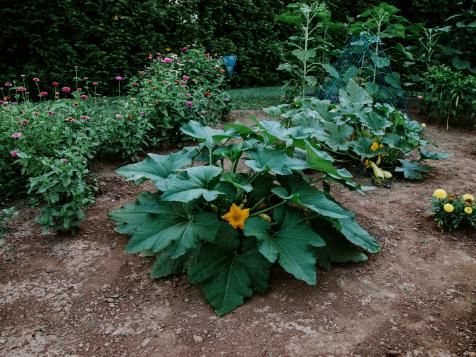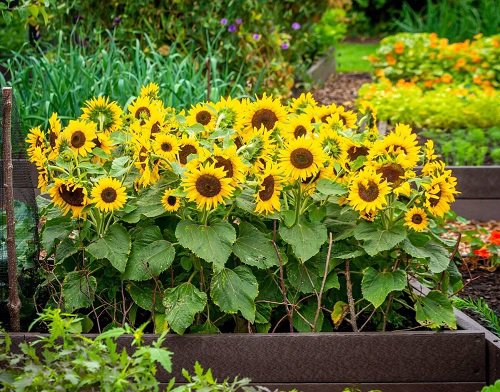Grow A Bountiful Harvest Of Yellow Squash With The Right Companion Plants
Yellow squash is a delicious and versatile vegetable that can be enjoyed in many different ways. It's also relatively easy to grow, but there are a few things you can do to ensure a bountiful harvest. One of the most important things is to choose the right companion plants.
Companion planting is the practice of planting certain crops together in order to benefit each other. Some plants, for example, can help to attract pollinators, deter pests, or improve the soil quality. When you choose the right companion plants for your yellow squash, you can help to improve its growth and productivity.
Here are some of the best companion plants for yellow squash:
- Beans: Beans are nitrogen-fixing plants, which means they can add nitrogen to the soil. This is beneficial for yellow squash, which is a heavy feeder. Beans can also help to suppress weeds and attract pollinators.
- Carrots: Carrots and yellow squash have different root systems, so they won't compete for resources. Carrots can also help to deter pests, such as carrot flies.
- Cucumbers: Cucumbers and yellow squash are both members of the cucurbit family, so they have similar growing requirements. They can also help to shade each other from the sun, which can help to prevent wilting.
- Lettuce: Lettuce is a cool-season crop, so it can be planted early in the spring or fall. It also doesn't require a lot of space, so it's a good choice for companion planting with yellow squash.
- Melons: Melons and yellow squash can be planted together in a "three sisters" garden. The three sisters garden is a traditional Native American planting method that involves planting corn, beans, and squash together. The corn provides support for the beans, the beans fix nitrogen in the soil, and the squash shades the roots of the other plants.
- Marigolds: Marigolds are a type of annual flower that can help to deter pests, such as squash bugs and beetles. They can also attract pollinators, which is important for yellow squash, which needs pollination in order to produce fruit.
- Nasturtiums: Nasturtiums are another type of annual flower that can help to deter pests. They can also improve the soil quality by attracting earthworms.
- Peas: Peas are another nitrogen-fixing plant that can benefit yellow squash. They can also help to suppress weeds and attract pollinators.
- Potatoes: Potatoes and yellow squash can be planted together in a "checkerboard" pattern. This planting pattern helps to prevent pests from spreading from one plant to another.
- Sunflowers: Sunflowers can help to shade yellow squash from the hot summer sun. They can also attract pollinators and improve the soil quality.
These are just a few of the best companion plants for yellow squash. When choosing companion plants, it's important to consider the growing conditions in your area and the specific needs of your yellow squash plants. With a little planning, you can grow a bountiful harvest of yellow squash with the help of the right companion plants.
Yellow squash is a delicious and versatile vegetable that can be enjoyed in many different ways. But did you know that there are certain plants that can help your yellow squash plants thrive?
Companion planting is a gardening practice that involves planting certain plants together to benefit each other. For yellow squash, some of the best companion plants include:
- Corn: Corn provides shade and support for yellow squash vines, while yellow squash helps to suppress weeds.
- Beans: Beans fix nitrogen in the soil, which is beneficial for yellow squash plants.
- Marigolds: Marigolds repel pests that can damage yellow squash plants.
- Nasturtiums: Nasturtiums also repel pests and attract beneficial insects that help to pollinate yellow squash flowers.
If you're interested in learning more about yellow squash companion plants, I recommend visiting Gardenia Inspiration. This website has a wealth of information on the topic, including a list of the best companion plants for yellow squash, as well as tips on how to plant and care for your yellow squash plants.
FAQ of yellow squash companion plants
- What are some good companion plants for yellow squash?
Some good companion plants for yellow squash include:
- Corn. Corn provides support for the yellow squash vines to climb, and it also helps to attract pollinators.
- Peas. Peas fix nitrogen in the soil, which benefits the yellow squash plants.
- Beans. Beans also fix nitrogen in the soil, and they can help to deter pests from yellow squash plants.
- Marigolds. Marigolds repel pests such as squash bugs and cucumber beetles, which can damage yellow squash plants.
- Nasturtiums. Nasturtiums also repel pests, and they can help to improve the soil quality around yellow squash plants.
- What plants should I avoid planting near yellow squash?
Some plants that you should avoid planting near yellow squash include:
- Potatoes. Potatoes and yellow squash are susceptible to the same diseases, so planting them near each other can increase the risk of disease transmission.
- Cucumbers. Cucumbers and yellow squash are both members of the cucurbit family, and they can cross-pollinate, which can produce fruits that are not true to type.
- Pumpkins. Pumpkins and yellow squash are both heavy feeders, so planting them near each other can compete for nutrients.
- Melon. Melons and yellow squash are both susceptible to the same pests, so planting them near each other can increase the risk of pest infestation.
- How far apart should I plant yellow squash?
Yellow squash plants need at least 3 feet of space between them to grow properly. If you are planting them in rows, the rows should be spaced at least 4 feet apart.
- How much sun do yellow squash plants need?
Yellow squash plants need full sun, at least 6 hours of sunlight per day. If you live in a hot climate, you may need to provide some shade for your yellow squash plants during the hottest part of the day.
- How much water do yellow squash plants need?
Yellow squash plants need regular watering, especially during hot, dry weather. Water your yellow squash plants deeply once a week, or more often if the weather is hot and dry.
Image of yellow squash companion plants
- Beans. Beans are a great companion plant for squash because they help to fix nitrogen in the soil, which is beneficial to squash plants. They also help to deter pests, such as cucumber beetles.

- Borage. Borage is a flowering plant that attracts beneficial insects, such as ladybugs and hoverflies, which help to control pests. It also produces nectar that can help to improve the flavor of squash.

- Cosmos. Cosmos is another flowering plant that attracts beneficial insects. It also helps to suppress weeds and improve the drainage of the soil.

- Nasturtiums. Nasturtiums are a colorful and edible flowering plant that can help to deter pests, such as squash bugs. They also help to improve the flavor of squash.

- Sunflowers. Sunflowers are tall plants that can help to provide shade for squash plants. They also help to attract beneficial insects and deter pests.

Post a Comment for "Grow A Bountiful Harvest Of Yellow Squash With The Right Companion Plants"